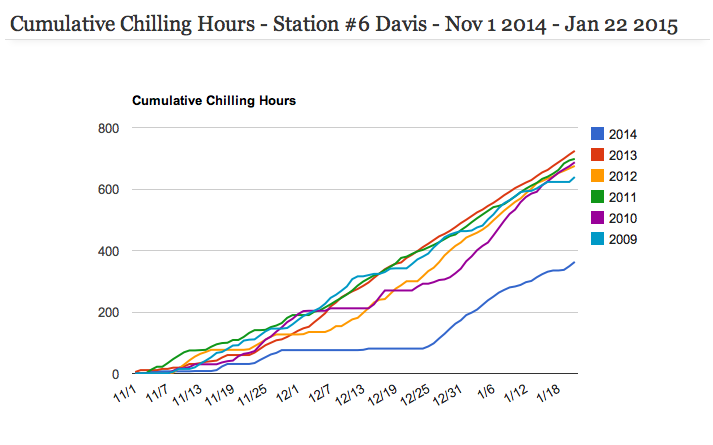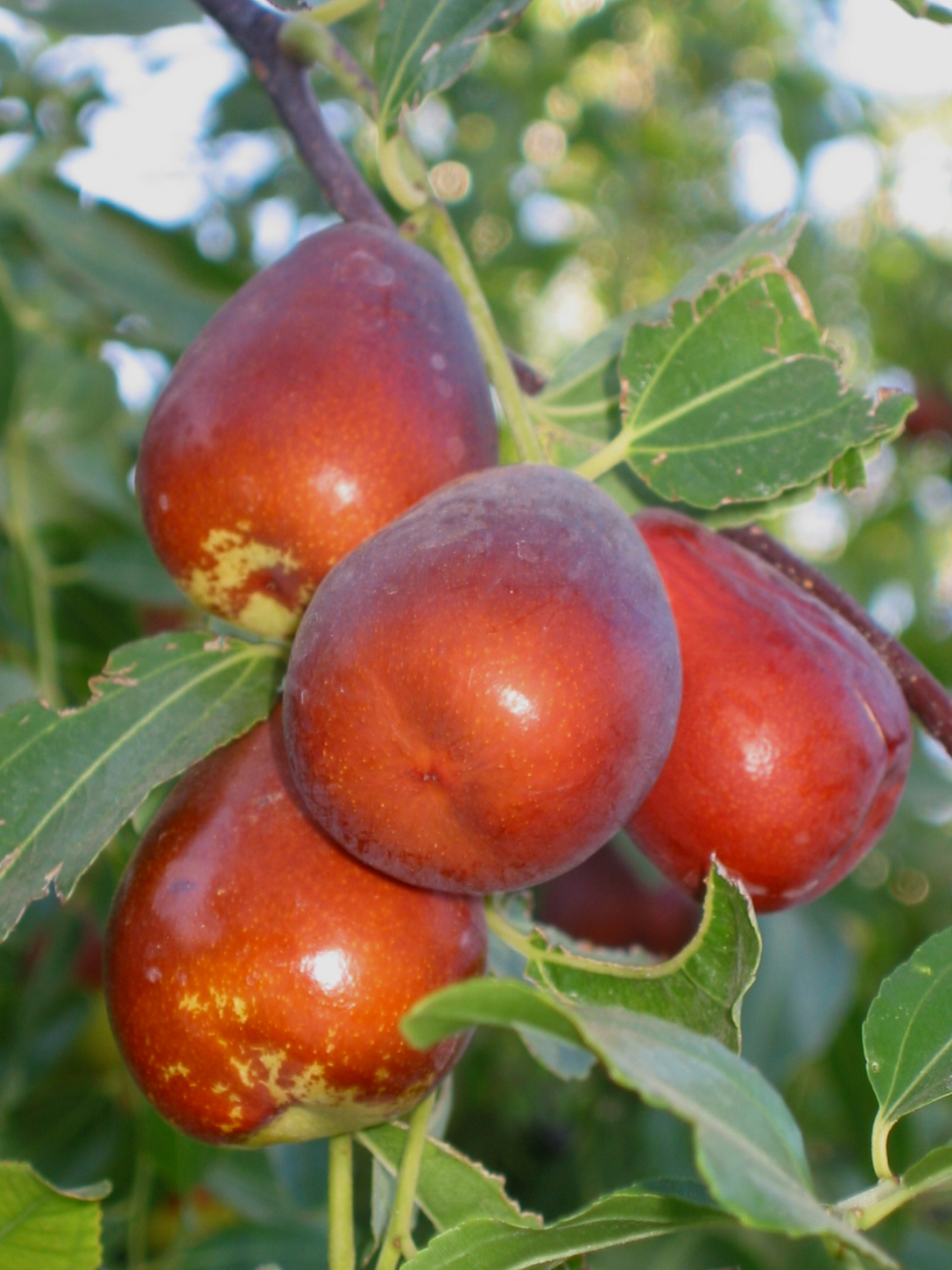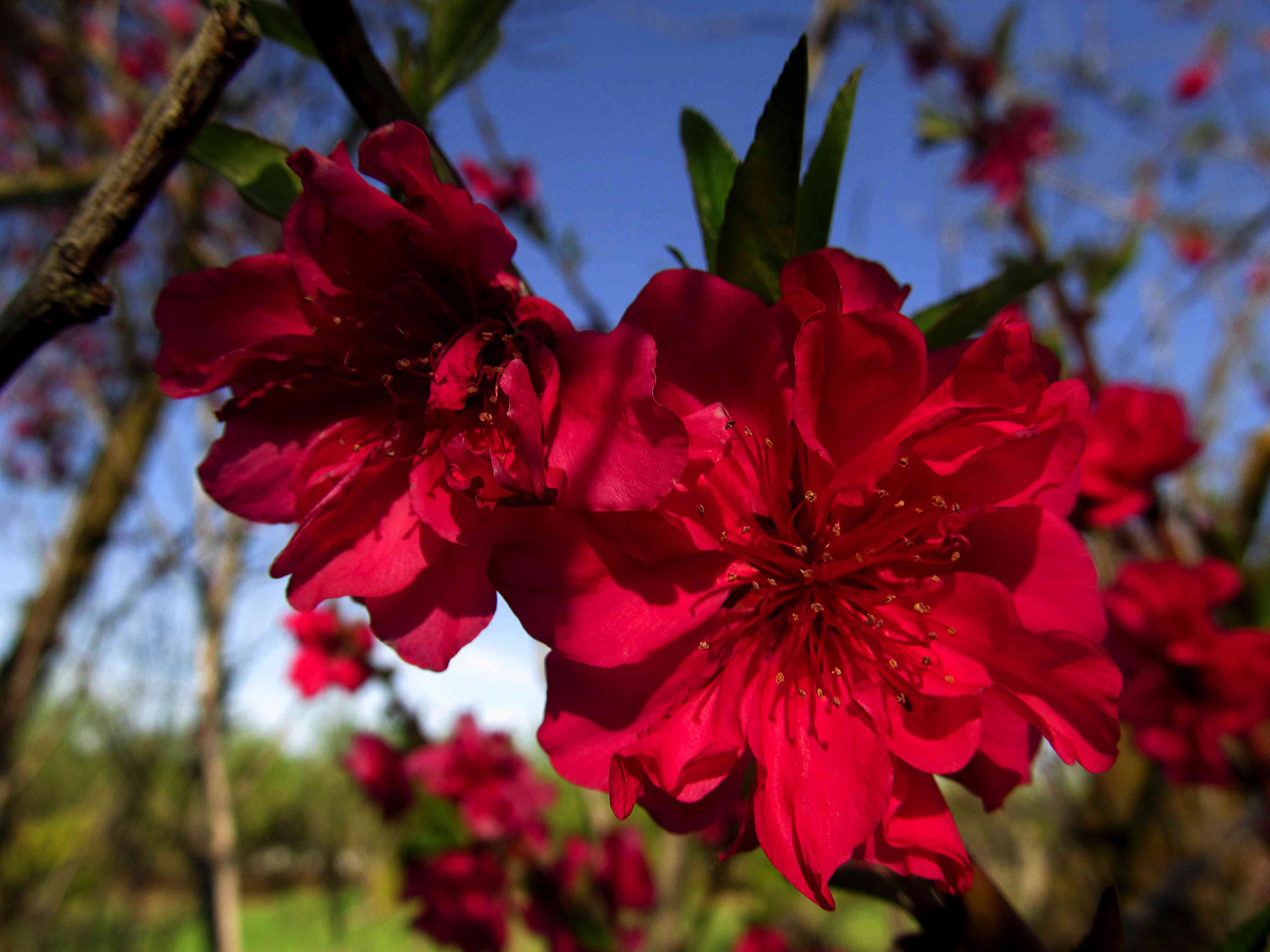Trouble ahead for fruit trees?
Written for the Davis Enterprise, January 22 2015
As I admired my February Gold daffodils blooming in January,
about three weeks ahead of schedule, I ruminated on the impact of the warm, wet
December and the sunny, dry January we've had so far.
In an average January we have 18.5 cloudy days. This January
we've had three. Not that most gardeners are complaining about the sunshine,
but that means that daytime highs are above average. The storms in December
were very warm, and much of the month was above average. We've only seen a few
frosty mornings so far. Overall our winter has been mild.
Unfortunately, some of our important crops and garden plants
count on having a normal amount of winter cold. Farmers are keeping a wary eye
on these temperatures. Growers of cherries, pistachios, and walnuts already
know their yields could be low this year. But the problem could extend to other
tree crops. There will be adverse impact on the state's economy. And you may
see reduced fruit production in your back yard as well. 
What are the effects of low chilling units?
Fruit tree scientists (pomologists) have known for years
that many species require a certain number of hours below 45 degrees and above
freezing. The trees have evolved mechanisms that prevent dormant buds
from growing until a certain amount of chilling, and then a certain amount of
warming, has occurred.
With insufficient chilling, the trees leaf out later
(delayed foliation). Flowers don't develop properly. Flowers open over a longer
period of time. Pollination doesn't happen properly. Pollenizers don't overlap
sufficiently in bloom to provide the right pollen when the flower is receptive.
Fruit yield and quality are reduced.
It's easy to see the evolutionary adaptation to delaying
flowering until freezing weather is past. Orchardists and home gardeners should
look for varieties appropriate to their region as to the number of "chilling
hours" required. If you're gardening in coastal or Southern California, you
can't grow the same varieties that do so well for us up here. Usually do well,
that is. We average over 800 hours of chilling here most years.
2015 is on track to have the lowest chilling hours
accumulation in many years. You can see for yourself where we stand by looking
at the weather models at http://fruitsandnuts.ucdavis.edu
Last year by January 20 Davis had 699 chilling hours, on the
way to a seasonal total of 871. This year? Less than half: 337 chilling hours to
date, and the weather forecast has warmer weather on tap for the coming week. I
had to go back to 1995 to find a year comparable to 2015. How did we do that
year? 545 chilling hours by the end of February. California's apricot
crop in 1995 was down 49%.
We've only got a few weeks left for stone fruits to
accumulate enough chilling hours. If temperatures are at or below average, we
will likely get to a little more than 500. But unfortunately the current
weather forecast shows a warming spell. Above average temperatures are not the
farmer's friend right now. As it stands, cherries and walnuts are likely to
have problems, as are some of your apples, pears, nectarines, and peaches.
Chilling units.
There's an added wrinkle. The old models for chilling hours
just counted the number of hours between 32 and 45 degrees. Temperatures below
freezing don't help. Temperatures above average weren't factored in. But
research shows that when daytime temperatures are higher than average, chilling
hours are reversed to a degree. Pomologists now measure the plant's dormancy
requirement in "chilling units." These have not been fully worked out for every
species and variety, but the bottom line is that unusually warm weather makes
things worse.
As if they didn't have enough problems already with Spotted
wing drosophila infesting the fruit, and drought affecting water supplies, California's
cherry growers got an unpleasant surprise in this regard last year. Cherries
are a high-chill crop, with most commercial varieties requiring 800 or more
hours. We had plenty of chilling hours, but high temperatures during January
and February 'undid' those. The trees' flowers didn't develop properly and
didn't set fruit. The USDA reported that California's cherry crop in 2014 was
63% below 2013. Many home gardeners had no fruit on their cherry trees last
year. 2015 looks like a repeat.
In the garden.
Other than higher prices at the grocery store, what does all
of this have to do with you?
Your backyard harvest is likely to be low, perhaps very low,
on some of your fruit trees. Others will do fine. Chilling requirements
vary by species and variety.

*
Very low chilling requirement, nothing to worry about: figs,
berries, grapes, jujube, mulberries, persimmons, pomegranates, and quince.
*
Moderately low chilling requirement, yields should be fine:
blueberries (Southern highbush, the most common here), Japanese plums, pluots
and apriums; almonds and pecans.
*
High chill types, yields likely to be low to very low this year:
many apples, some apricots, Northern highbush blueberries, sweet cherries, many
peaches and nectarines, some pears, European (prune) plums, walnuts.
Should we shift to planting low-chill varieties? Probably
not now or in the near future. It is expected that chilling hours will decrease
in the Sacramento Valley by 20 – 25% over the next several decades. But
it won't be a straight-line decline; there will be warmer winters, and colder
winters. The lifespan of a fruit tree is a couple of decades. Your kids should
probably give this some thought if they go into walnut production. You and I
probably don't need to make drastic changes in our selection of varieties.
Why not plant low-chill varieties anyway?
Because most of the best-flavored types of peaches
and nectarines have higher chill requirements, and this isn't an issue most
years. Elberta, Loring, and O'Henry peaches – all among the tops for
flavor – require about 800 hours. Rio Oso Gem and Redhaven peach and
Independence nectarine require 900 hours. The latter two are important
commercial varieties. But for home gardeners the occasional low-crop year is
more than compensated by the quality in other years. If you want some
insurance, just add a lower-chill type nearby.
*
June Gold cling peach and Goldmine nectarine can all take 450
hours or less. Red Baron peach, which has spectacular flowers and very good fruit
that ripens over several weeks, only requires 250.
or less. Red Baron peach, which has spectacular flowers and very good fruit
that ripens over several weeks, only requires 250.
*
In pears, the Asian types only need 400 – 450 hours. European
varieties Kieffer and Moonglow are fine with 400 – 500 hours; Pineapple
only needs 200. Those also have good fireblight resistance, which is important
in selecting pears. Better-known varieties such as Bartlett and d'Anjou have
higher needs at 800 and 700 hours respectively (and very poor fireblight
resistance).
*
Lower-chill apples include Anders, Fuji, Gala, Granny Smith, and
Pink Lady, all less than 500 hours. Gravenstein (700) and Honeycrisp (800) may
have poor yields this year. Many heirloom apple varieties have high chilling
requirements.
*
Harcot apricot, recommended for brown rot resistance, needs 700
hours, but the ever-popular Blenheim only requires 4 – 500.
Fruit trees aren't the only plants affected by a lack of
winter chilling. I expect there will be reduced bloom on lilacs and peonies.
Lilac varieties differ, with some having been bred for tolerance of warmer
winters, so results will vary.
In sum: nurseries and master gardeners are going to spend a
lot of time this summer answering the question "why didn't I get fruit?"
Answer: the winter was too warm for some of our favorite types of fruits and
nuts. There's always next year!
Chilling hours by type, with selected varieties (pdf)
